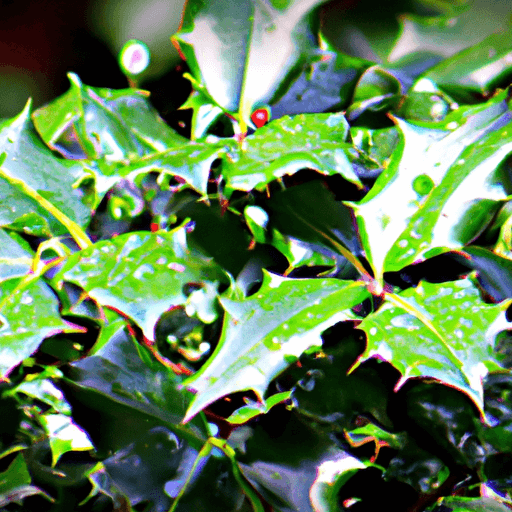Nellie R. Stevens holly thrives under specific conditions, requiring the right amount of sunlight, well-draining soil, appropriate watering, suitable temperature and humidity levels, and proper fertilizer application.
This holly variety flourishes in full sun to partial shade, with adequate sunlight being crucial for optimal growth and berry production. The soil should be well-draining and slightly acidic, preventing waterlogged roots and allowing nutrient absorption.
Nellie R. Stevens holly prefers warm weather, tolerates frost, and requires 1 to 2 inches of water per week. Fertilizer should be applied in the spring with a slow-release 10-10-10 fertilizer, following instructions to avoid over-fertilization.
Light and Sun Requirements
Nellie R. Stevens holly thrives in full sun to partial shade, making it essential to find the right balance of sunlight for its health. This holly variety requires a sufficient amount of sunlight exposure to ensure optimal growth and berry production. However, it also has a remarkable shade tolerance, which can protect the plant from extreme heat and sunburn.
Finding the perfect balance of sunlight is crucial for maintaining the overall health and vigor of the Nellie R. Stevens holly. It is recommended to provide the plant with at least 4-6 hours of direct sunlight per day, while also offering some shade during the hottest part of the day. This will help prevent leaf scorch and maintain the plant’s ability to photosynthesize effectively.
Soil Requirements
Well-draining and slightly acidic soil is considered ideal for the growth of Nellie R. Stevens holly. This type of soil provides optimal conditions for the plant’s root development and nutrient uptake. A soil pH range of 5.5 to 6.5 is preferred, as it allows for better absorption of essential nutrients. To achieve the desired pH level, organic matter amendments can be incorporated into the soil. This can be done by adding compost, leaf mold, or peat moss to increase the organic matter content. These amendments help improve soil structure, water retention, and nutrient availability. Additionally, they promote beneficial microbial activity, which aids in nutrient cycling and plant health. It is important to regularly test the soil pH and make necessary adjustments to ensure the best growing conditions for Nellie R. Stevens holly.
| Soil pH | Organic Matter Amendments |
|---|---|
| 5.5 – 6.5 | Compost |
| Leaf Mold | |
| Peat Moss |
Watering Needs
Adequate watering is crucial for maintaining the health and vitality of the Nellie R. Stevens holly plant. This holly variety requires 1 to 2 inches of water per week to thrive.
However, it is important to avoid excessive watering, as it can lead to root rot. Nellie R. Stevens holly is known for its drought tolerance once established, meaning it can withstand dry periods without significant damage.
The watering frequency should be adjusted based on weather conditions. During hot and dry periods, it may be necessary to increase the frequency of watering to prevent the plant from becoming stressed.
Temperature, Hardiness, and Humidity
Southern states in the United States, such as Virginia, the Carolinas, and Georgia, provide suitable conditions for the growth of Nellie R. Stevens holly due to their warm weather and ability to tolerate frost.
This evergreen shrub thrives in USDA plant hardiness zones 6-9 and prefers warm temperatures. It can withstand occasional frost, making it a resilient choice for gardeners in these regions.
Nellie R. Stevens holly also adapts well to different humidity levels, making it versatile in various climates. Whether it’s a humid summer or a drier period, this plant can handle the fluctuations.
Its temperature tolerance and adaptability to humidity levels make it a popular choice for landscaping projects in the South, where these conditions prevail.
Fertilizer Application
Using a slow-release 10-10-10 fertilizer in the spring, gardeners can promote healthy growth of Nellie R. Stevens holly. This balanced fertilizer contains equal amounts of nitrogen, phosphorus, and potassium, providing essential nutrients for the plant’s development. Slow-release fertilizers have the advantage of releasing nutrients gradually over time, ensuring a steady supply for the holly’s needs.
Additionally, organic fertilizers offer several benefits over synthetic ones. They improve soil structure, promote microbial activity, and enhance nutrient availability. Gardeners can also make their own organic fertilizer at home by composting kitchen scraps, yard waste, and other organic materials. Composting allows for the natural decomposition of these materials, resulting in nutrient-rich compost that can be used to feed the Nellie R. Stevens holly and other plants in the garden.
Frequently Asked Questions
Can Nellie R. Stevens Holly Tolerate Full Shade?
Nellie R. Stevens holly tolerates partial shade but thrives in full sun. However, excessive shade can negatively affect its growth. It’s essential to find the right balance of sunlight to ensure optimal growth and berry production.
Is It Possible to Grow Nellie R. Stevens Holly in Clay Soil?
Yes, it is possible to grow Nellie R. Stevens holly in clay soil. However, it is not the best soil condition for optimal growth. Amending the clay soil with organic matter can improve its drainage and nutrient absorption capabilities.
How Often Should I Water Nellie R. Stevens Holly During the Winter?
Nellie R. Stevens holly should be watered sparingly during winter to prevent root rot. Adjust watering frequency based on weather conditions. For propagation, use stem cuttings or layering techniques. Prune in late winter or early spring to maintain desired shape.
Can Nellie R. Stevens Holly Survive in USDA Plant Hardiness Zone 5?
Nellie R. Stevens Holly may not survive in USDA plant hardiness zone 5. It thrives in zones 6-9. Comparing growth in different hardiness zones shows that it prefers warmer climates.
What Are Some Signs of Over-Fertilization in Nellie R. Stevens Holly?
Signs of over-fertilization in Nellie R. Stevens holly include leaf burn, stunted growth, and yellowing foliage. It is crucial to use the optimal fertilizer ratio, following the manufacturer’s instructions to prevent harm to the plant.







